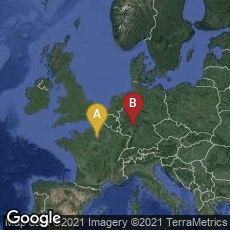

A: Paris, Île-de-France, France, B: Innenstadt I, Frankfurt am Main, Hessen, Germany
"The first printing machines used in France were of foreign manufacture, beginning in 1823 with a two-cylinder made by Applegath for the Bulletin des lois, Paris, and a 'presse à gros cylindres' for Firmin Didot. Two years later the Journal des Débats and Le Globe were printed on Napier drum cylinder machines. A general printer, Fournier, of rue de Seine, ordered a large Applegath cylinder in 1827, and by that year there were twelve printing machines at work in Paris, eight of which were of English origin" (Moran, Printing Presses [1973] 140).
The year after Hansard published his Typographia Maurice Ernst Audouin De Geronval issued the first printing manual in French to discuss machine printing: Manuel de l'imprimeur (Paris: Crapelet, 1826). This little-known work, dedicated to the physician J.-L. Alibert because of Alibert's "noble usage de l'imprimerie" presumably in various of Alibert's publications, is probably the second printing manual to discuss the design and operation of "machine presses." Interestingly, Audouin's manual, printed in 12mo format, was an early volume in the Roret series. Audouin focused on the most efficient printing technology then available. With respect to presses he emphasized the Stanhope handpress, and a rotary machine of the Koenig type. Later in his book he illustrated a rotary machine that he says was ordered for the printing of the Journal des débats, the most widely read newspaper in France during the Restoration and July Monarchy periods. Notably the machine illustrated was designed to be driven by a large hand-crank rather than a steam engine. The plate that Geronval published was an exact copy of the plate reproduced by Hansard in his Typographia. From this we may assume that the Journal des débats had ordered a copy of the Napier "Nay-peer" machine of Hansard's design. In the first part of the 19th century France, like Germany, lagged behind England in the development of steam technology, and it is likely that the Journal wished to experiment with machine printing without the complications of a steam engine.
The first book published in German to provide an early history of the development of machine printing was the Handbuch der Buchdruckerkunst issued anonymously in Frankfurt in 1827. Its author was Benjamin Krebs. Krebs, who referred frequently to Hansard's work, devoted his entire chapter five of the third section (pp. 547-640) to the development of printing machinery (Schnellpresse) from its conceptualization by Nicholson up to the time of writing. As one would expect, he devoted considerable space to the contributions of Friedrich Koenig, but also discussed available early printing machines from other manufacturers.